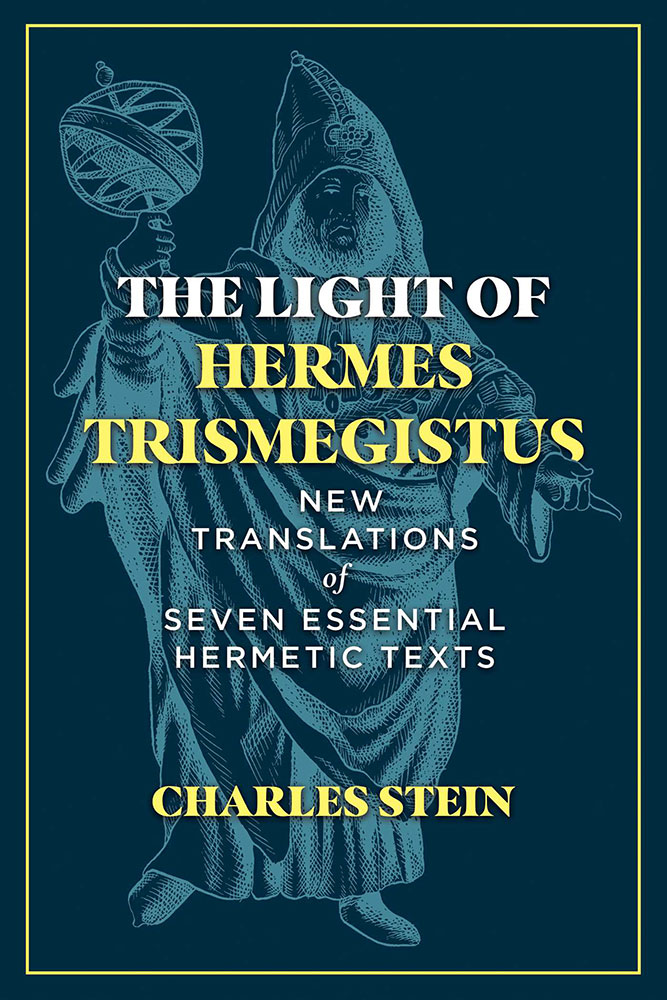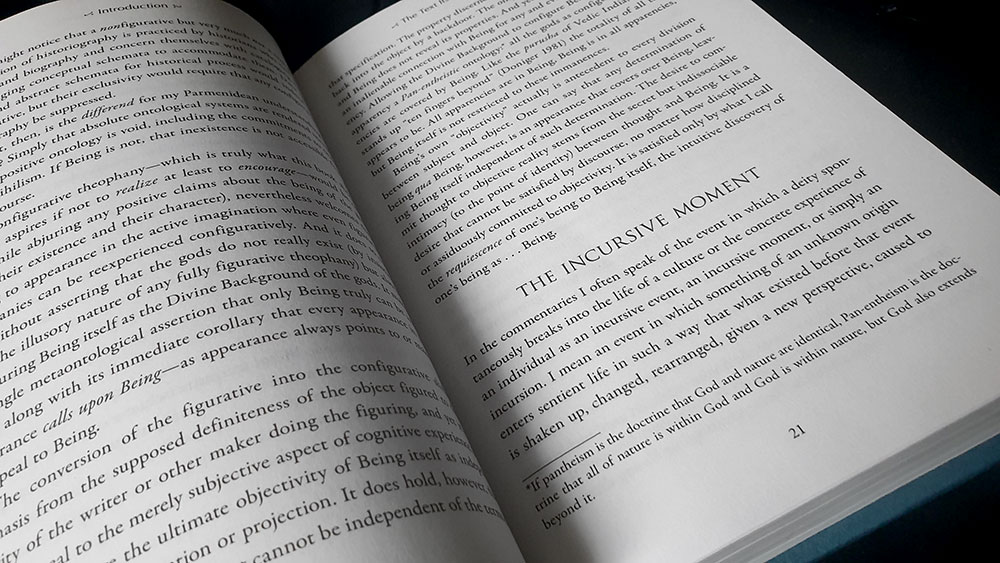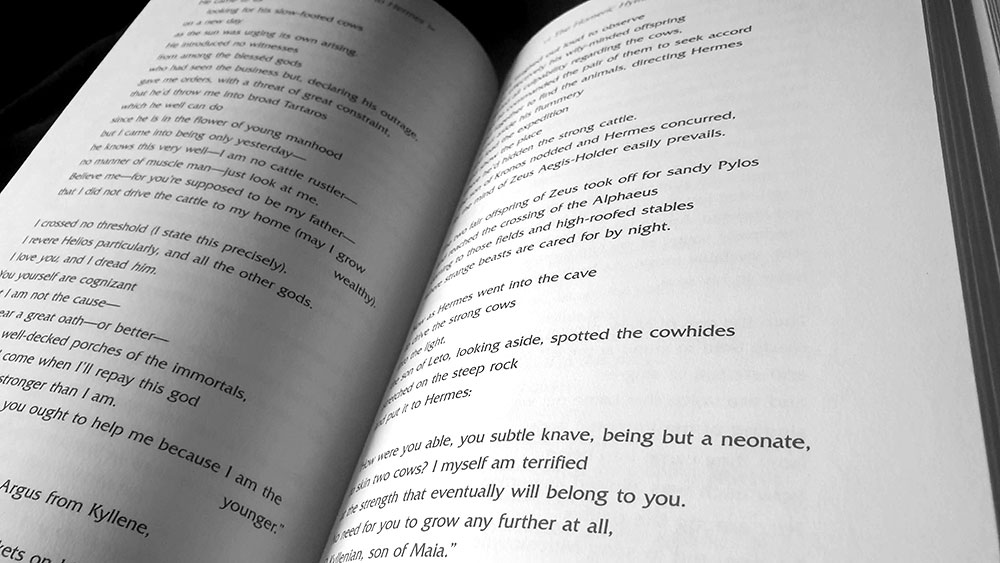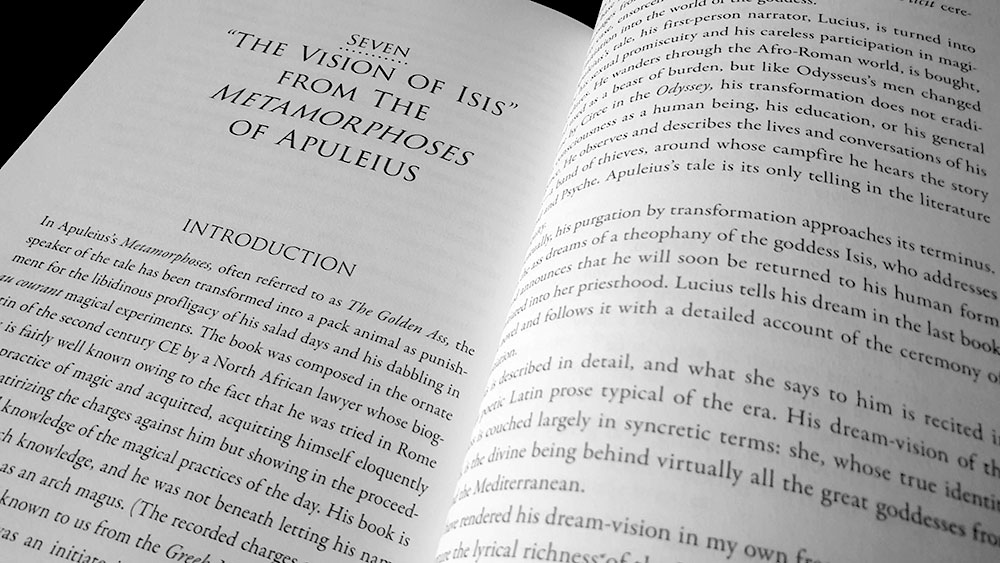 Charles Stein’s The Light of Hermes Trismegistus is one of those releases from Inner Traditions that feels a little different from their usual fare, appearing as something for shelving in the reference section, rather than the personal growth or practical magic ones. Stein has a Ph.D. in literature and a bachelor’s degree in ancient Greek, and in the past he has principally published works of poetry, as well as a Persephone-focussed study of the Eleusian Mysteries. With this new book he provides translations of what are categorised here as seven essential Hermetic texts, each drawn from the earliest written source, and with context and further insights provided by Stein’s preamble and voluminous commentaries.
Charles Stein’s The Light of Hermes Trismegistus is one of those releases from Inner Traditions that feels a little different from their usual fare, appearing as something for shelving in the reference section, rather than the personal growth or practical magic ones. Stein has a Ph.D. in literature and a bachelor’s degree in ancient Greek, and in the past he has principally published works of poetry, as well as a Persephone-focussed study of the Eleusian Mysteries. With this new book he provides translations of what are categorised here as seven essential Hermetic texts, each drawn from the earliest written source, and with context and further insights provided by Stein’s preamble and voluminous commentaries.
Despite a subtitle promising “seven Hermetic texts,” the works included here come from a period that spans several centuries, beginning in the seventh century BCE and ending in the fourth century CE, with only one of them, Poimandres, having provenance within that great canon of Hermetic thought, the Corpus Hermeticum. Thus, instead of being texts that could be specifically defined, in a purely technical sense, as Hermetica, these are works that pull on threads various, drawing from Greek myth, the Homeric Hymns, Neoplatonism, archaic alchemy, and (in the case of Apuleius’ The Metamorphoses) picaresque novels from ancient Rome. The one occasional through-line amongst these temporally and culturally diverse texts is Hermes, whether he appears as the divine messenger of Greek myth, as seen in Hesiod’s Theogony, or as the later Hellenistic syncretic form of the fabled Hermes Trismegistus; with Stein regarding the mythic and the legendary incarnations as largely one and the same.
Stein opens with a substantial introduction, outlining his focus on Hermes in a rather personal and devotional manner, describing him as the very principle of the mind in all its possibilities. Here, Stein makes clear his intent, defining this work as an exercise in what he calls configurative theology, with an attendant configurative theophany, emphasising the concept of hermeneutics, in which the translation and interpretations of a text perpetuate it in new, ever evolving ways.
Hesiod’s Theogony is the first work featured here, with Stein translating from the original Greek as recorded in Hugh G. Evelyn-White’s 1977 collection of the Homeric Hymns and works by Hesiod. As a poem dated to the eighth or seventh century BCE, this is the piece furthest from the traditional corpus of Hermetica, retelling the creation of the world. In his commentary, Stein ties this act of cosmic creation to Hesiod’s text itself, saying that Theogony does not simply describe the act but rather, through the reading thereof, initiates it. This is emblematic of Stein’s hermeneutic approach to this material, using etymology, historical precedent and philosophy to present it as not only profound, but inherently magical.
Rather than providing a line-by-line analysis of each text, Stein’s commentary is often focussed little on the specific textual content itself, and instead uses the works as starting off points for broader discussions of each core theme. Sometimes this extends far beyond the source texts, such as in the translation of a text by Zosimos of Panopolis, which is followed by an extensive overview of alchemy that stretches centuries, even millennia beyond the fourth century origins of the source; embracing everything from the Greek Magical Papyri to seventeen and eighteenth century alchemists, but without too much reference to the text itself.
This book’s Hermes-focussed brief finds a good fit in the Homeric Hymn to Hermes, for which Stein provides a nimble translation followed by commentary focussed on the themes of magical voice and conscious listening. This is the abruptly book ended by an assemblage of somewhat contextless and usually brief additional comments on various matters from within the hymn, some as little as a sentence long, each divided by a short row of bullet points as if they were research notes that have been formatted into the chapter by mistake (not that they were).
In the next section, The Poem of Parmenides, Stein translates the fragments of Parmenides’ sole surviving work, usually retroactively referred to, though not here, as On Nature. Here the following commentary is less an exegesis on matters metaphysical and is, for the most part, purely textual in its focus, with a selection of notes about the translation.
Stein’s translations are often functional with a literal approach that predicates economy over poeticism. His translation of The Poimandres, for example is almost staccato in its brevity, with none of the free verse flourish and beauty of G.R.S. Mead’s version. The same is true of the Chaldean Oracles, though this is largely due to the fragmentary nature of the very source material. For the version here, Stein has used only 87 of the 260 extant fragments, and, diverging from the ordering template established in 1894 by Wilhelm Kroll, has rearranged them as if they make up a single poem.
After a free verse reinterpretation of the vision of Isis sequence from Apuleius’ prose The Metamorphoses, Stein concludes with a translation of a foundational but innominate alchemical text by Zosimos of Panopolis, in which the 4th century Greco-Egyptian alchemist related a series of visionary dream journeys. This translation dates from 1964, using a text found in the Columbia University Library (though Stein notes that the exact source document is unknown as he no longer has the reference), and it was first published the same in his own single issue journal of the occult and the phenomenology, Aion: A Journal of Traditionary Science. For his translation, Stein uses the title On Divine Virtue and follows it with a commentary that is significantly longer than the mere five pages of entries from Zosimos’ dream journal.
Priscilla Harris Baker provides the text design and layout for The Light of Hermes Trismegistus, using Garamond for body copy and Trajan, Optima and Gill Sans as display faces. The translations themselves are formatted in Friz Quadrata, a pleasant enough modern serif, but one that feels a little incongruous for content from the Hellenistic and Roman eras. With its heavier than usual typographic weight, it is a face that seems more suited for display purposes, and at this point size, the tiny serifs almost disappear, giving the impression of a bulky san serif whose readability is not ideal for often poetically-formatted text. Like another Hermetic-themed work recently published by Inner Traditions, Marlene Seven Bremner’s Hermetic Philosophy and Creative Alchemy, this book has been granted a little more finesse than their usual trade paperbacks. It is presented as a sturdy hardback wrapped in a fetching blue-hued dustjacket, with foiled gold text on both jacket and spine; though it must be said that the gold of the title makes it hard to read against the blue background of the dustjacket.
Published by Inner Traditions




